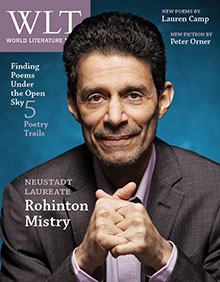Sie / Er by Botho Strauss
 Munich. Hanser. 2012. ISBN 9783446238657
Munich. Hanser. 2012. ISBN 9783446238657
If you aren’t yet familiar with Botho Strauss, one of Germany’s most critically acclaimed prose writers of the last forty years and arguably its most well-known current dramatist, then the recently released Sie/Er, a collection of thirty-five stories originally published between 1987 and 2009, will serve as an excellent introduction to his oeuvre, style, and especially mastery of language. Ranging in length from just a half-page to almost forty pages long, the stories, all set in contemporary German society, are distinguished by Strauss’s uncanny perception of human interaction, emotional responses and expectations, and spoken and unspoken language. Though the stories take place in everyday settings, from cafés and restaurants to residences and workplaces, they do not revolve around an action or event; rather, Strauss offers the reader a voyeuristic gaze into the private and personal lives of his literary creations with all of their fears, disappointments, love, misery, and happiness.
Despite what the title might insinuate, this book is not an anthology of love stories; rather, it is a collection of stories about individuals and their explicit and implicit desire to be connected with others and to society. A profound sense of fragmentation, alienation, and longing permeates the entire collection, even though the individual stories are not necessarily sad, tragic, or even happy. Strauss is an acute observer of reality, and his stories reveal his attention to detail, from exact description of characters and their appearances to their thoughts and emotions. The wide range of characters, from girls to divorced couples, from children to mothers-in-law, and the characters’ insecurities, regrets, excitement, and naïveté invite the reader to reflect on his or her life; indeed, the reader may even glimpse as aspect of herself in each story.
Above all, the stories are about communication and the need to speak and use language in a meaningful, social way. Many of the stories reveal a certain impediment to or crisis of communication: an elderly woman anxiously awaiting an afternoon of discussion with her daughter and son-in-law only to find out that they forgot the appointment, or a mother obsessively driven to find out why a complete stranger despises children. Strauss’s concern with the problem of communication and alienation may best be illustrated by a passage from “Frau mit Telefon.” A lonely, middle-age woman, who desperately wants company for the evening, has resigned herself to her isolation, yet . . . “Am frühen Nachmittag klingelte noch einmal das Telefon. Sie blickte befremdet von ihrer Näharbeit auf und betrachtete den scheinbar le-bendigen Apparat. Sie zögerte einen Moment. Wie sprechen? Wie empfangen? Wie hören?” (The telephone rang in early afternoon. Astonished, she glanced up from her sewing and stared at the apparently alive phone. She hesitated a moment. To speak . . . but how? To answer the phone . . . but how? To listen . . . but how?) Will she pick up the phone?
Gregory H. Wolf
North Central College

